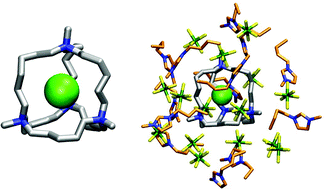Halide anion solvation and recognition by a macrotricyclic tetraammonium host in an ionic liquid: a molecular dynamics study†
Abstract
We report a molecular dynamics study of

* Corresponding authors
a
Laboratoire MSM, Institut de Chimie, UMR CNRS 7177, Université Louis Pasteur, 4, rue B. Pascal, Strasbourg, France
E-mail:
wipff@chimie.u-strasbg.fr
We report a molecular dynamics study of

 Please wait while we load your content...
Something went wrong. Try again?
Please wait while we load your content...
Something went wrong. Try again?
A. Chaumont and G. Wipff, New J. Chem., 2006, 30, 537 DOI: 10.1039/B518109G
To request permission to reproduce material from this article, please go to the Copyright Clearance Center request page.
If you are an author contributing to an RSC publication, you do not need to request permission provided correct acknowledgement is given.
If you are the author of this article, you do not need to request permission to reproduce figures and diagrams provided correct acknowledgement is given. If you want to reproduce the whole article in a third-party publication (excluding your thesis/dissertation for which permission is not required) please go to the Copyright Clearance Center request page.
Read more about how to correctly acknowledge RSC content.
 Fetching data from CrossRef.
Fetching data from CrossRef.
This may take some time to load.
Loading related content
